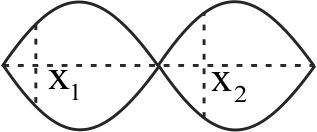355131
Equations of a stationary and travelling waves are as follows
\({y_1} = a\sin kx\cos \omega t\,{\text{and }}{y_2} = a\sin (\omega t - kx)\)
The phase difference between two points \(x_{1}=\dfrac{\pi}{3 k}\) and \(x_{2}=\dfrac{3 \pi}{2 k}\) is \(\phi_{1}\), in the standing wave \(y_{1}\) and is \(\phi_{2}\) in travelling wave \(\left(y_{2}\right)\) then \(\dfrac{\phi_{1}}{\phi_{2}}\) is
355131
Equations of a stationary and travelling waves are as follows
\({y_1} = a\sin kx\cos \omega t\,{\text{and }}{y_2} = a\sin (\omega t - kx)\)
The phase difference between two points \(x_{1}=\dfrac{\pi}{3 k}\) and \(x_{2}=\dfrac{3 \pi}{2 k}\) is \(\phi_{1}\), in the standing wave \(y_{1}\) and is \(\phi_{2}\) in travelling wave \(\left(y_{2}\right)\) then \(\dfrac{\phi_{1}}{\phi_{2}}\) is
355131
Equations of a stationary and travelling waves are as follows
\({y_1} = a\sin kx\cos \omega t\,{\text{and }}{y_2} = a\sin (\omega t - kx)\)
The phase difference between two points \(x_{1}=\dfrac{\pi}{3 k}\) and \(x_{2}=\dfrac{3 \pi}{2 k}\) is \(\phi_{1}\), in the standing wave \(y_{1}\) and is \(\phi_{2}\) in travelling wave \(\left(y_{2}\right)\) then \(\dfrac{\phi_{1}}{\phi_{2}}\) is
355131
Equations of a stationary and travelling waves are as follows
\({y_1} = a\sin kx\cos \omega t\,{\text{and }}{y_2} = a\sin (\omega t - kx)\)
The phase difference between two points \(x_{1}=\dfrac{\pi}{3 k}\) and \(x_{2}=\dfrac{3 \pi}{2 k}\) is \(\phi_{1}\), in the standing wave \(y_{1}\) and is \(\phi_{2}\) in travelling wave \(\left(y_{2}\right)\) then \(\dfrac{\phi_{1}}{\phi_{2}}\) is
355131
Equations of a stationary and travelling waves are as follows
\({y_1} = a\sin kx\cos \omega t\,{\text{and }}{y_2} = a\sin (\omega t - kx)\)
The phase difference between two points \(x_{1}=\dfrac{\pi}{3 k}\) and \(x_{2}=\dfrac{3 \pi}{2 k}\) is \(\phi_{1}\), in the standing wave \(y_{1}\) and is \(\phi_{2}\) in travelling wave \(\left(y_{2}\right)\) then \(\dfrac{\phi_{1}}{\phi_{2}}\) is

